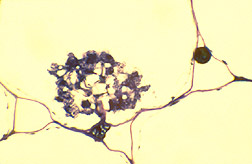This page has been archived and is being provided for reference purposes only. The page is no longer being updated, and therefore, links on the page may be invalid.
|
Read: Details in Agricultural Research magazine.
|
Bringing Back Native Soil FungiBy Don ComisMay 14, 2001 When you think of endangered species, you never think of soil fungi. Yet the fungi that make plants hardier have had their numbers greatly reduced by the intensive agriculture practiced in the United States since the 1950s. Agricultural Research Service scientists are trying to figure out how to put these beneficial soil fungi back, as farmers make the transition to using less chemicals. Lead scientist Philip E. Pfeffer and colleagues David Douds and Gerry Nagahashi at the ARS Eastern Regional Research Center in Wyndmoor, Pa., are learning how to grow and package the fungi for practical use on farms. One approach the researchers are evaluating is to mix the fungi--called mycorrhizae--into potting soil planted with grass or other host plants. Farmers would buy these “inoculated” seedlings and plant them in compost. Then, after the fungi multiplied, farmers would apply the colonized compost with manure spreaders. The mycorrhizal fungi are beneficial organisms that live on plant roots and help them extend their reach for water and fertilizer. In exchange, the plant gives the fungi the sugar they need to grow. The most common type lives inside root cells and extends long, rootlike threads into the soil. Farmers today have to rely on whichever of these native fungi survived years of chemical use--from synthetic fertilizers to fungicides. ARS scientists are testing the compost idea at the Rodale Institute Experimental Farm in Kutztown, Pa., which was founded by the late Robert Rodale, a leader in modern American organic farming. They also have experiments under way at Stoneleigh Estates, near Wyndmoor. An ultimate goal is to produce the fungi in large quantities efficiently and economically, without host plants. They would then be applied as a biofertilizer before planting. You can read more about this research in a story in the May issue of ARS' Agricultural Research magazine. The story also is on the World Wide Web. ARS is the chief scientific research agency in the U.S. Department of Agriculture. Scientific contact: Philip E. Pfeffer, ARS Eastern Regional Research Center, Wyndmoor, Pa., phone (215) 233-6400, fax (215) 233-6581, ppfeffer@arserrc.gov. |

